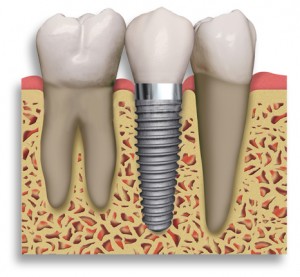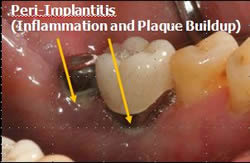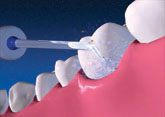After spending tons of money on your dental implant procedure, surely you would want your investment to last. Though it make look and feel like a real tooth, dental implant maintenance is required to ensure your dental implants stay in top-notch condition for a very long time.
Why do we need dental implant maintenance?
Extreme care of the oral hygiene is essential in maintaining dental implants. Dental plaque and tartar tend to accumulate more rapidly, in larger amounts and attach more easily to the implant abutment than to natural teeth. The skin tissue barrier and connective tissue attachment mechanism is not as strong around an implant tooth when compared to a natural tooth. This weaker attachment allows for a more rapid invasion of bacteria into the biologic seal which can contribute to the destruction of osseous integration (the combination process of the bone to titanium alloy of implant).
Effective plaque removal is a critical factor in the maintenance of a healthy biologic seal around the teeth implants and to prevent implant failure. The amount of plaque and subsequent gum disease correlates with the bone loss around implants.
What happens if we do not maintain dental implants?
The loss of natural teeth resulting in the placement of implants is often caused by a history of poor oral hygiene resulting in dental disease. A commitment to meticulous daily oral hygiene self-care is critical for those with implants. Cleaning the abutment posts, bars, and prosthetic superstructures of implants presents a challenge that can be even more demanding than cleaning natural teeth. As with natural teeth, a combination of devices is usually needed to remove plaque from all surfaces.
The goal of implant maintenance is to regularly remove soft deposits without altering the surface of the implants. Damage to titanium implants can increase corrosion and affect the molecular interaction between the implant surface and host tissue. A scratched surface may lead to increased plaque accumulation and the subsequent bacterial invasion can progress rapidly to inflammation of the gum tissues surrounding the implant (peri-implantitis) and potential implant failure.
How do we maintain dental implants?
An effective brushing technique should be the first component of an implant oral hygiene self-care regimen. A soft, manual toothbrush can be used though a sonic powered toothbrush has been shown to be better than a manual toothbrush in reducing plaque and bleeding scores around implants. Whatever brush is used, a demonstration of the adaptation of the brush to the abutment posts (the main structure of the implant) and pontics (the artificial or false tooth) should be provided. The dentifrice used should meet American Dental Association standards to ensure that it is not abrasive to the titanium surface.
To aid in plaque removal from abutment posts, there are a variety of other devices that can be utilized. A tapered or cylindrical shaped interproximal brush or uni-tufted brush can be used with an in-and-out motion to clean the abutment posts or the areas in between the teeth. The interproximal brush must have a nylon-coated wire rather than the standard metal wire to prevent scratching the implant with the tip of the interproximal brush. Foam tips are an alternative choice for cleaning the interproximal surface of an implant. To help control bacteria, the foam tip, interproximal brush, or either of the powered brushes may be dipped into an antimicrobial solution such as chlorhexidine gluconate (0.12%). Alternately, a cotton swab can be used to apply the agent.
Any type of floss, tape, or yarn can be used for plaque removal around abutment posts edges. In some cases, traditional floss with a floss threader, variable thickness floss or gauze can be placed in a 360-degree loop around the abutment post and moved with a shoeshine motion in the direction of the long axis of the tooth. Alternately, floss products designed specifically for use with implants can be used. Ribbon floss is a wide, woven, sometimes braided, gauze-like version of floss, which provides increased texture to enhance plaque removal. Placing a small amount of nonabrasive toothpaste on the flossing product can polish the posts.
Oral irrigators can be used for cleaning around abutments, however, the water spray should be used on the lowest setting and should not be directed into the gum pockets. Daily irrigation of the gum pockets with 0.06% chlorhexidine has shown beneficial effects on gums, plaque, bleeding, and tartar scores.
A critical factor in successful implant maintenance as with all oral health self-care is to recommend only the minimal number of cleaning devices needed for effective plaque removal. With proper instruction, the motivated individual can successfully maintain implants.



